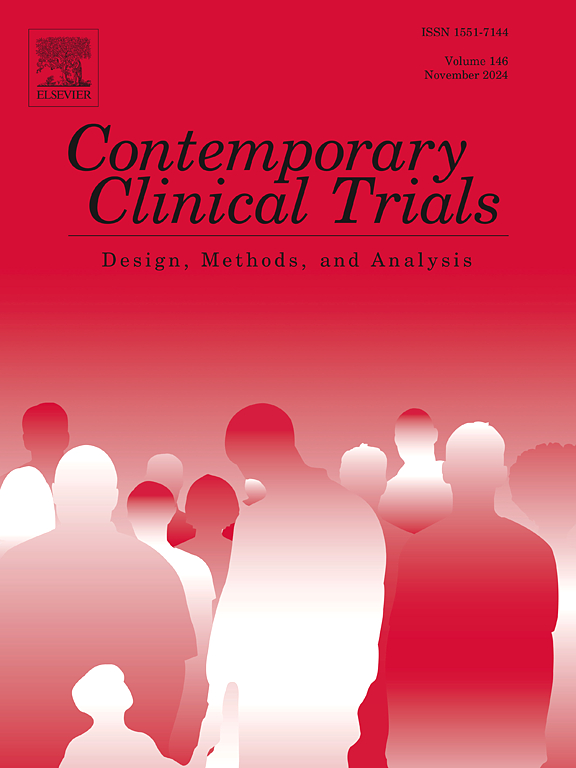利用贝叶斯预试验模拟优化儿童肾病综合征适应性临床试验设计
IF 2
3区 医学
Q3 MEDICINE, RESEARCH & EXPERIMENTAL
引用次数: 0
摘要
背景:在罕见的儿科疾病中,随机对照试验(RCTs)通常是不可行的。适应性试验可以在保持科学效度的同时提高试验效率。我们的目的是通过模拟确定儿童肾病综合征贝叶斯自适应随机对照试验的最佳设计。方法:我们使用模拟方法来评估候选贝叶斯自适应临床试验设计,用于比较低剂量和标准剂量类固醇治疗儿童肾病综合征复发的计划非劣效性随机对照试验。每个设计都有自适应设置的独特组合(停止阈值、无效边际、初始招募和中期分析频率)。我们为每个设计模拟了10,000个随机对照试验,以估计工作特性(功率、1型错误率和平均样本量)。在合理的随机对照试验条件下(不同的治疗效果、招募率和先验分布)对最佳设计进行了测试。我们对540个具有独特适应设置组合的自适应随机对照试验(540万次模拟试验)中的每个设计模拟了10,000次试验。对于排名前三的设计,我们在40种不同的RCT条件下模拟了另外10,000次试验(120万次模拟试验)。最佳试验设计与最小的平均样本量、最小的不确定试验概率和1型错误率相关。5%。与频率随机对照试验相比,使用具有信息先验的贝叶斯自适应设计减少了71%的样本量(n = 198 vs. n = 682)。结论贝叶斯试验模拟可优化儿童肾病综合征适应性随机对照试验的设计,降低估计样本量。适应性设计可以减少在罕见儿科疾病中进行随机对照试验的障碍。本文章由计算机程序翻译,如有差异,请以英文原文为准。
Using Bayesian pre-trial simulations to optimize the design of adaptive clinical trials in childhood nephrotic syndrome
Background
Randomized controlled trials (RCTs) are often infeasible in rare pediatric diseases. Adaptive trials can increase trial efficiency while maintaining scientific validity. Our aim was to determine the optimal design of a Bayesian adaptive RCT in childhood nephrotic syndrome using simulation.
Methods
We used simulation to evaluate candidate Bayesian adaptive clinical trial designs for a planned non-inferiority RCT comparing low-dose vs. standard-dose steroids for childhood nephrotic syndrome relapses. Each design had a unique combination of adaptive settings (stopping thresholds, futility margin, initial recruitment, and interim analysis frequency). We simulated 10,000 RCTs for each design to estimate operating characteristics (power, type 1 error rate, and mean sample size). The best designs were tested under plausible RCT conditions (varying treatment effect, recruitment rate, and prior distributions).
Results
We simulated 10,000 trials for each of 540 adaptive RCT designs with unique combinations of adaptation settings (5.4 million simulated trials). For the top three designs, we simulated another 10,000 trials under 40 different RCT conditions (1.2 million simulated trials). The optimal trial design was associated with the lowest mean sample size, smallest probability of an inconclusive trial, and a type 1 error rate < 5 %. Compared to a frequentist RCT, using this Bayesian adaptive design with an informative prior decreased sample size by 71 % (n = 198 vs. n = 682).
Conclusions
Bayesian trial simulation was used to optimize the design of an adaptive RCT in childhood nephrotic syndrome, lowering estimated sample size. Adaptive designs can reduce barriers to conducting RCTs in rare pediatric diseases.
求助全文
通过发布文献求助,成功后即可免费获取论文全文。
去求助
来源期刊
CiteScore
3.70
自引率
4.50%
发文量
281
审稿时长
44 days
期刊介绍:
Contemporary Clinical Trials is an international peer reviewed journal that publishes manuscripts pertaining to all aspects of clinical trials, including, but not limited to, design, conduct, analysis, regulation and ethics. Manuscripts submitted should appeal to a readership drawn from disciplines including medicine, biostatistics, epidemiology, computer science, management science, behavioural science, pharmaceutical science, and bioethics. Full-length papers and short communications not exceeding 1,500 words, as well as systemic reviews of clinical trials and methodologies will be published. Perspectives/commentaries on current issues and the impact of clinical trials on the practice of medicine and health policy are also welcome.

 求助内容:
求助内容: 应助结果提醒方式:
应助结果提醒方式:


